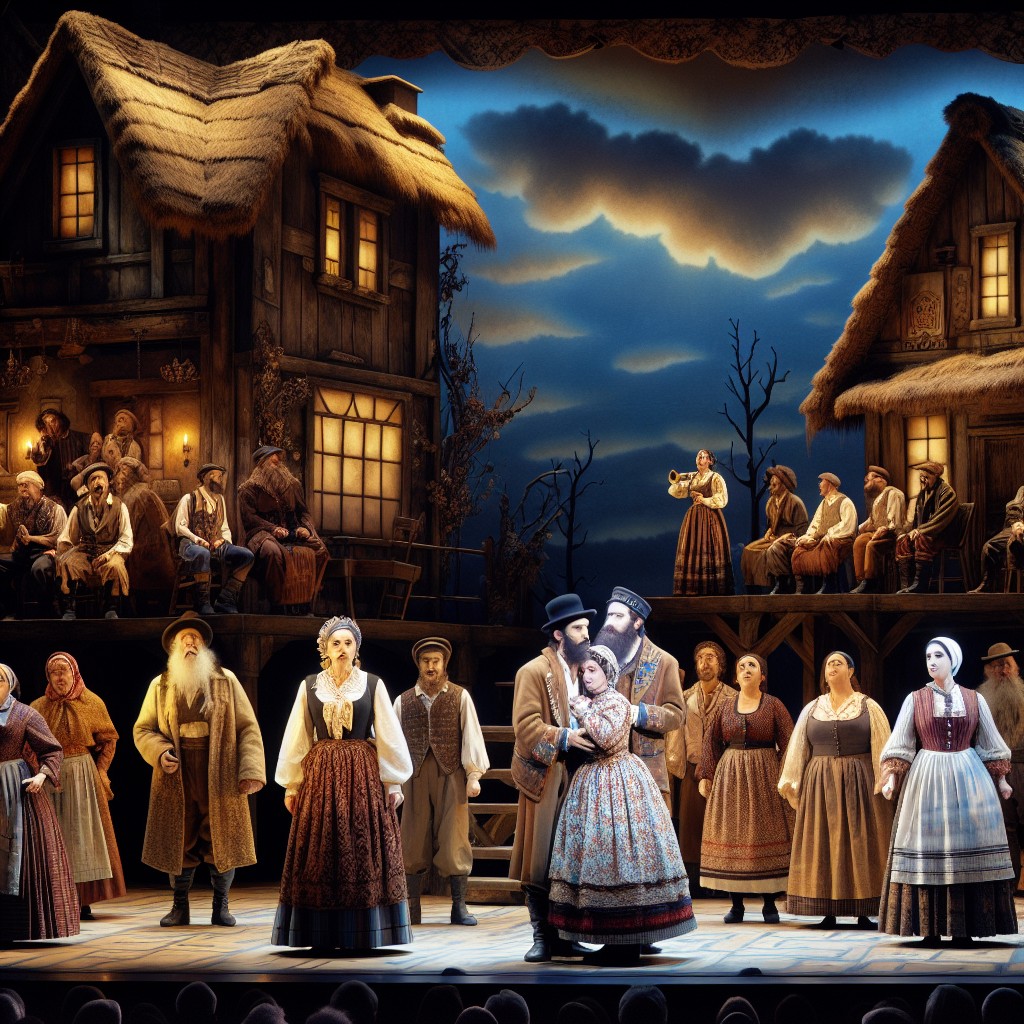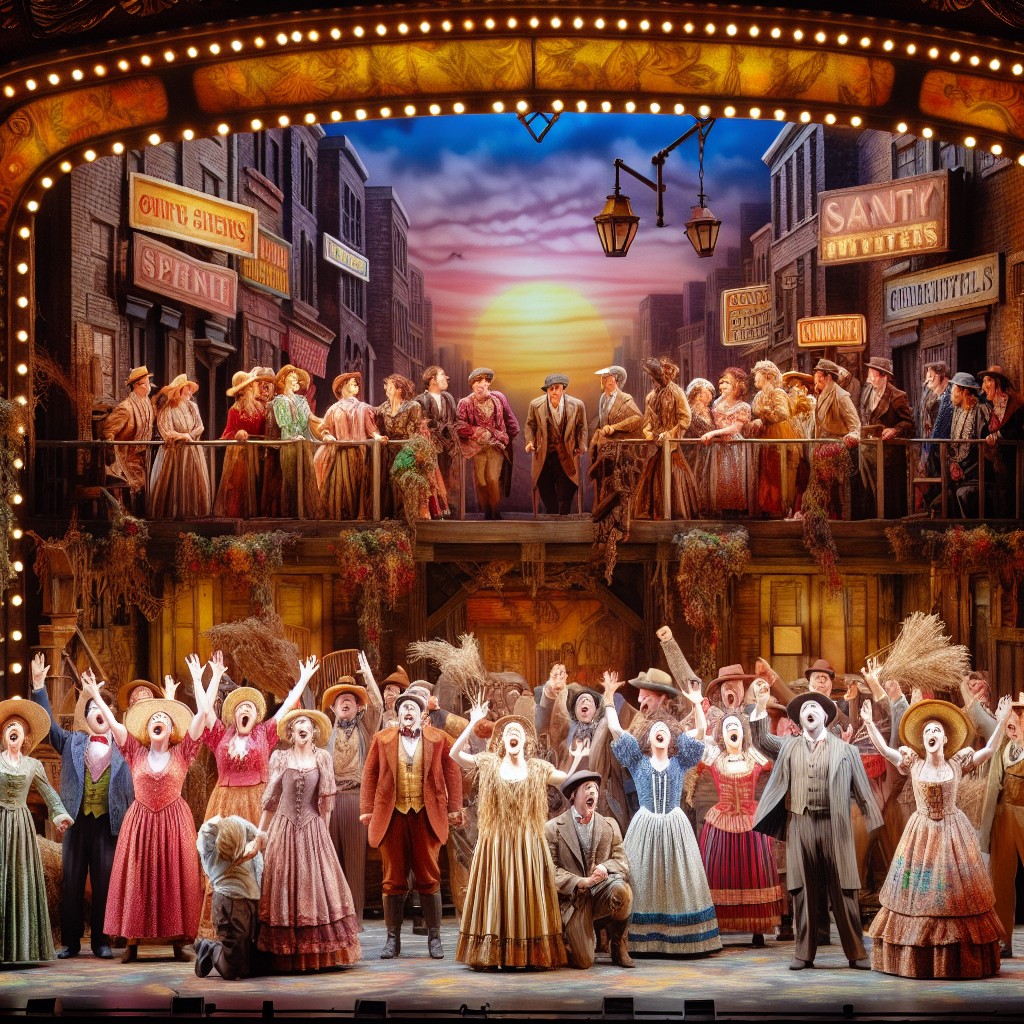Last updated on
Featuring spectacular performances from a vibrant cast, “Fiddler on the Roof” is an absolute must-see at the Chicago Theatre because it flawlessly balances gut-wrenching drama with doses of sparkling humor.
Key takeaways:
- Refreshed take on a classic with a modern backdrop
- Talented cast brings characters to life with depth
- Lush orchestrations and captivating choreography elevate the score
- Resonates across cultures with universal themes of tradition and change
- Standing ovations and praise for heartfelt performances
Lyric Opera of Chicago Presents FIDDLER ON THE ROOF

The Lyric Opera of Chicago’s staging of “Fiddler on the Roof” offers audiences a refreshed take on a classic. This production is directed by the acclaimed Barrie Kosky, known for his innovative approach to opera and theater. The musical’s rich tableau is set against a backdrop that marries traditional design with modern sensibilities, offering both the charm of the shtetl and the universality of its themes—family, tradition, and change.
In this incarnation of the beloved Broadway hit, the role of Tevye, the philosophical milkman, is portrayed with a blend of warmth, humor, and pathos. True to the spirit of the original, this staging weaves together the historically poignant with the endearingly personal, while touching on the contemporary relevance of the story’s core questions.
With the full force of the Lyric Opera’s resources, the production boasts lush orchestrations and vocal performances that elevate the familiar score to new heights. Attention to choreographic detail pays homage to the original Jerome Robbins’ dance sequences, resulting in an experience that is as visually arresting as it is emotionally stirring.
As one of the central cultural events in Chicago’s artistic calendar, this production promises to be both a nostalgic journey for those who hold the musical dear, and a vibrant new encounter for those experiencing it for the first time.
Performance Dates and Times

The production will grace the stage from March 18th through April 15th, with a variety of showtimes to accommodate different schedules. Evening performances are typically scheduled for 7:30 PM on weekdays and Saturdays, while Sundays offer a 2:00 PM matinee option.
Additional matinee shows are available on select Wednesdays and Saturdays. It’s advisable to check the official Lyric Opera schedule to confirm specific dates and times as they may be subject to change. Patrons are encouraged to book tickets in advance to secure their preferred seats.
Ticket Purchasing Options
Securing your spot to witness “Fiddler on the Roof” in Chicago is straightforward. Patrons can purchase tickets directly from the Lyric Opera’s official website, which offers real-time seat selection and e-ticketing options.
For those who prefer a personal touch, the Lyric Opera’s box office is available for walk-up or phone transactions. Group sales and special rates for students are also available for qualifying individuals.
In addition, season subscribers have the benefit of priority seating, ensuring the best spots well before tickets become available to the general public. It’s advisable to book early to guarantee seats, especially for weekend performances, which tend to fill up quickly.
Cast and Characters
The production showcases a talented ensemble that brings to life the inhabitants of Anatevka, a small Jewish village in Tsarist Russia. At the forefront is Tevye, the warm-hearted milkman, portrayed with both humor and depth, grappling with tradition and changing times. Alongside him, his wife Golde offers a strong-willed counterbalance, navigating family challenges with resilience.
Each of Tevye’s five daughters – Tzeitel, Hodel, Chava, Shprintze, and Bielke – provides a unique perspective on the generational shifts and the quest for personal happiness versus communal expectation. Their suitors, including the revolutionary Perchik, the shy tailor Motel, and the non-Jewish Fyedka, reflect the broader social changes impacting their community.
Yente the matchmaker adds a touch of humor with her meddlesome ways, while the figure of the Rabbi embodies the spiritual traditions central to village life.
The characters embody a cross-section of hopes, fears, and aspirations, each contributing to the story’s rich tapestry, with the cast’s performances pivotal in conveying the emotional nuances of this beloved musical.
Cultural Significance of FIDDLER ON THE ROOF
“Fiddler on the Roof” transcends the boundaries of a traditional musical to offer a profound exploration of community, tradition, and identity.
At its heart, the story reflects the struggle of maintaining cultural roots amid a rapidly changing world.
Set in the shtetl of Anatevka in 1905 Tsarist Russia, it showcases the resilience of the Jewish community through the trials of Tevye, the dairyman, who must reconcile his deep-seated traditions with the evolving aspirations of his daughters.
The musical’s enduring relevance lies in its universal themes of family, faith, and the forces of change that challenge every generation.
Audiences worldwide connect with its poignant portrayal of the human condition and the bittersweet acknowledgment that the bonds of heritage and love must sometimes adapt to survive.
Its educational value is significant, offering insight into the life of Eastern European Jews before the revolutions and upheavals of the 20th century, which helps foster cultural understanding and empathy.
Insight Into the Production By Barrie Kosky
Barrie Kosky’s approach to this timeless classic infuses it with a fresh perspective without straying from the roots that make it so beloved. His interpretation emphasizes the evolving nature of tradition and family within the story, providing a deeper emotional connection for the audience.
Kosky’s emphasis on the universality of the themes in “Fiddler on the Roof” allows the production to resonate across various cultures and generations. Notably, attention is paid to the choreographic elements, leveraging dance as a storytelling medium to highlight the characters’ inner turmoil and joys.
Kosky’s version honors the original while also unveiling new layers of narrative and character development, giving audiences both a sense of nostalgia and the thrill of new discovery.
Iconic Musical Numbers
“Fiddler on the Roof” captivates audiences with an array of memorable songs that have seeped into popular culture. “Tradition” sets the tone, highlighting the importance of cultural customs in the characters’ lives.
Tevye’s introspective “If I Were a Rich Man” conveys his dreams and yearnings with humor and pathos. The tender “Sunrise, Sunset” reflects on the passage of time during Tzeitel’s wedding, a bittersweet moment that resonates with many.
The optimistic “Matchmaker, Matchmaker” showcases the young sisters’ hopes for love before the stark realities of life intrude. Each musical number is woven into the emotional fabric of the story, ensuring that melodies linger long after the curtain falls.
Audience Reactions and Reviews
The revival of “Fiddler on the Roof” at the Lyric Opera of Chicago has elicited a standing ovation from audiences, reflecting its unwavering popularity. Patrons praise the heartfelt performances, with particular commendation for the lead actor’s embodiment of Tevye, showcasing an impeccable balance of warmth and tenacity.
Reviews highlight the production’s fidelity to tradition while also injecting a fresh vibrancy that resonates with modern viewers. The enthralling choreography, alongside the rousing orchestra, has been noted as a high point, invigorating the classic numbers with renewed energy.
Theatergoers appreciate the attentiveness to the musical’s core themes—family, tradition, and resilience—as they strike a chord in today’s social landscape. Notably, post-show discussions often center on the emotional depth and how the story’s relevancy continues to bridge generational gaps, solidifying the production as a cultural touchstone.
Health and Safety Protocols: MASKS
To ensure a safe experience for all attendees, the following health protocols are in place:
- Mandatory Masks: Patrons must wear masks at all times within the theater, except when eating or drinking in designated areas.
- Type of Masks: Cloth masks are acceptable, but surgical or higher-grade medical masks are recommended for better protection.
- Mask Fitting: It’s important that masks cover both nose and mouth snugly without any gaps.
- Mask Availability: For those who arrive without one, masks will be available at the entrance.
- Compliance: Staff members will be present to assist with compliance and provide reminders if needed.
These measures are part of the concerted effort to keep the community healthy and to make the theater experience enjoyable for everyone involved.
Nearby Amenities: Dining and Parking
Adjacent to the Lyric Opera House, a variety of dining options cater to every taste and budget. From upscale eateries to casual bistros, theatergoers can enjoy a pre-show meal within walking distance. Restaurants often offer special menus timed to ensure patrons arrive at their performance promptly.
Regarding parking, there are multiple parking garages and lots in close proximity to the theater. Some facilities provide advance purchase options, which can be a convenient choice to secure a spot on busy show nights. Additionally, several garages offer discounted rates for Lyric Opera patrons. It’s recommended to verify the closing times of these parking venues to avoid any inconvenience post-performance.
FAQ
What town was Fiddler on the Roof based on?
Fiddler on the Roof" was based on a Ukrainian village named Anatevka.
What is the meaning of Fiddler on the Roof?
Fiddler on the Roof" symbolizes survival amidst uncertainty and the adherence to tradition amidst changing times.
What is the true story behind Fiddler on the Roof?
Fiddler on the Roof" is a musical adaptation of a series of short stories by Sholem Aleichem, depicting the historically accurate account of Jewish life in pre-war eastern Europe, specifically in the fictional village of Anatevka.
Why is Fiddler on the Roof so famous?
Fiddler on the Roof is famous due to its exploration and deep representation of Jewish tradition, identity, customs, and relationships through its compelling plot.
How does the setting of Chicago influence the rendition of Fiddler on the Roof?
The setting of Chicago influences the rendition of Fiddler on the Roof by adding a robust urban backdrop to the story’s themes of tradition and cultural change.
What unique elements does the Chicago production of Fiddler on the Roof incorporate?
The unique elements that the Chicago production of Fiddler on the Roof incorporates include a modern twist on the traditional story, a diverse cast portraying the different characters, and innovative stage design and choreography.
How has the reception of Fiddler on the Roof in Chicago compared to other cities?
Fiddler on the Roof has been received with equal fervor and appreciation in Chicago as in other cities.
Related
- Fiddler on the Roof: Origins, Plot, and Legacy Explained
- Fiddler on the Roof Movie: Plot, Cast, and Legacy Explained
- Red Roof Inn Joliet: Comprehensive Hotel Review and Guest Experience Insights
- Red Roof Plus West Palm Beach: Comprehensive Hotel Review and Information Guide
- Lucky Lady Casino Roof Collapse: Comprehensive News Report and Analysis
